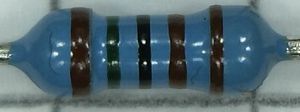LED Cube/PCB Soldering Manual: Unterschied zwischen den Versionen
Marvin (Diskussion | Beiträge) |
Marvin (Diskussion | Beiträge) |
||
| Zeile 52: | Zeile 52: | ||
|} | |} | ||
<gallery perrow=3> | <gallery perrow=3> | ||
File:lcpcb-02-00.jpg|the reset resistor | File:lcpcb-02-00.jpg|the reset resistor... | ||
File:lcpcb-02-01.jpg| | File:lcpcb-02-01.jpg|...placed and soldered | ||
</gallery> | </gallery> | ||
Version vom 28. April 2012, 11:17 Uhr
Vorlage:LED Cube Series This page contains the soldering manual for the PCB of the LED Cube.
A full schematic of the PCB can be downloaded here: Datei:Cube.pdf.
USB Resistors

First we solder R10, R11 and R13. As all resistors we are using in this project, their orientation is not relevant. You can see the resistor values in the schematic or in the table below, together with the color code marking:
| Name | Value | Color Code |
|---|---|---|
| R10 | 68 Ohm |  (blue-green-black-gold-brown) (blue-green-black-gold-brown)
|
| R11 | 68 Ohm |  (blue-green-black-gold-brown) (blue-green-black-gold-brown)
|
| R13 | 1500 Ohm |  (brown-green-black-brown-brown) (brown-green-black-brown-brown)
|
To solder them, first bend both leads about 90 degrees, so they fit into the two holes. The distance between the leads, as with every resistor we will solder on this board, is about 11 mm, but it is not important to be very accurate here. Place them into the holes, flip the PCB and solder them on the back side. Afterwards, clip away any excess wire, but do not damage the solder joint by clipping away more than necessary.
-
plain PCB
-
the three resistors
-
If you want to be accurate, make sure the distance between the bends is 11 mm.
-
board with placed resistors
-
backside view
-
backside after soldering
-
after clipping away the excess leads
USB Zener Diodes

Additionally, we need two 3.6 V Zener diodes for the data lines, Z1 and Z2. Here, you have to pay attention to their orientation. The (black) line on the diode is the same as the single line on the symbol (as opposed to the triangle) that is printed onto the PCB. You can see that in the figure on the left.
The solder process looks just like the one of the resistors, but this time, if you want to be accurate, you have to bend the diode legs so they are 7.5 mm apart.
-
the two Zener diodes
-
this time, the distance between the leads is 7.5 mm
-
PCB with the diodes placed
-
back side
-
back side after soldering
-
back side after clipping
Reset Resistor

The Reset pin gets a 10 kOhm resistor R12 to the 5 V line. Again, have a look in the table for the correct color markings. Orientation is irrelevant.
| Name | Value | Color Code |
|---|---|---|
| R12 | 10 kOhm |  (brown-black-black-red-brown) (brown-black-black-red-brown)
|
-
the reset resistor...
-
...placed and soldered
Column Resistors
If you bought a kit or attend a workshop, you probably already got the correct Resistors. There should be (at least) nine of the same value. Just solder them into the places for R1 to R9.
If you are supplying your own LEDs or did not get matching resistors for any other reason, you have to pay attention: The ideal column resistors should be chosen for each LED color separately. You are always on the safe side, if you choose a high value, but then your cube may not be as bright as you want it to be. If you are interested in this, read LED Cube/Column Resistors in Detail. Alternatively, here is a table of common colors, their forward voltages and the recommended resistor value:
| Color | Forward Voltage | Resistor Value | Color Code |
|---|---|---|---|
| Red | 1.9 V | ? | Datei:R-?.jpeg (?-?-?-?-?) |
Column and Plane Connectors


Now add the column and plane connectors to CONN1 to CONN10.
Capacitors
We need four capacitors, two times 100 nF (C1, C2) and two times 22 pF (C3, C4). See the schematic at the left or the table below for their values and positions. Again, all four devices are symmetric and orientation is irrelevant.

| Name | Value | Marking |
|---|---|---|
| C1 | 100 nF | 104 |
| C2 | 100 nF | 104 |
| C3 | 22 pF | 220 |
| C4 | 22 pF | 220 |
Crystal
Now you should add the 16 MHz crystal U3. You do not have to care about its orientation.
-
16 MHz Crystal
Transistor Array

Now add the transistor array U2. Pay attention to the orientation! There is a marker in the package that can also be seen on the PCB.
Microcontroller socket

Add the microcontroller socket to the PCB at U1. As with the Transistor array, there is a small marker on the package which should be on the same side as the marker on the PCB.
USB Socket

Now add the USB socket. This should be straightforward. You should solder the two big shield connectors on the side, not just plug them in, to increase the stability.
Bootloader Jumper
Now we need the bootloader Jumper CONN12.








































